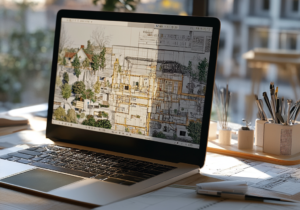
The use of Building Information Modeling (BIM) in construction projects has gone from a nice-to-have to a standard expectation. BIM helps teams design, plan, and manage construction more efficiently. But none of that works without the right talent driving it. That’s where hiring a qualified BIM designer becomes one of the most important decisions you’ll make during a project.
Whether you’re renovating a single building or developing an entire commercial complex, having the right BIM professional on board affects your timelines, costs, collaboration, and overall results. So, if you’re unsure how to find someone who’s truly capable, or don’t quite know what to expect from a BIM design process, keep reading.
A BIM designer creates intelligent 3D models that go far beyond traditional drawings. These models aren’t just visual—they hold data that supports decision-making throughout the construction cycle. A good BIM designer helps architects, engineers, and contractors stay aligned on a single source of truth.
They model everything from structural systems and mechanical layouts to electrical and plumbing schematics. The role isn’t just about producing nice visuals. It’s about helping everyone involved work smarter, not harder.
BIM designers translate sketches and engineering concepts into full digital models. These models track quantities, highlight potential conflicts, and streamline approval processes. Depending on the stage of the project, a BIM designer might update drawings, collaborate with engineers, or adjust parameters based on evolving site data.
Some specialize in early-stage conceptual modeling. Others focus on construction detailing or facilities management models. Knowing what you need for your project helps narrow down your search.
Not all BIM designers are the same. Some work as generalists, while others stick to mechanical, structural, or architectural specialties. A BIM professional with experience in civil projects might not be the best fit for a high-rise building. Similarly, someone great at producing concept visuals may not be your go-to for technical modeling of HVAC systems.
A BIM designer must know their tools inside out. At a minimum, they should be comfortable with Autodesk Revit, Navisworks, and AutoCAD. However many firms also use ArchiCAD, Bentley, or industry-specific platforms. If your team works in a particular ecosystem, your designer should be fluent in it.
This also applies to how they manage model coordination, clash detection, and 4D sequencing. Look for someone who knows how to bring data and design together—not just someone who can draw.
Experience counts for a lot in BIM design. Projects are faster and smoother when your designer has worked on similar builds before. If you’re designing a healthcare facility, someone who’s done three apartment buildings may not have the insight you need.
This doesn’t mean new talent can’t be valuable. But if your project has tight regulatory requirements, ambitious sustainability targets, or complex multi-trade collaboration, go with someone who’s been through it before.

BIM designers don’t work in silos. They’re in constant contact with architects, engineers, and contractors. Clear communication is key—especially when models need to be updated under pressure or reviewed in front of stakeholders. If they can’t explain what they’ve built in the model, or why something won’t work, that’s a red flag.
Great BIM designers know how to take feedback, handle changes, and clarify issues before they become real problems. In other words, technical skills get them in the door. Soft skills keep them there.
BIM design services go beyond 3D modeling. They often include construction documentation, quantity take-offs, clash detection, and even facilities management data. The more your BIM designer understands the full project lifecycle, the more valuable they become.
Some designers offer these services independently. Others work within firms that manage the entire design process. Understanding which approach fits your needs can help you filter out options that might not offer the depth you’re after.
A strong BIM portfolio tells you a lot. Look for real-world examples that match the scale and complexity of your project. Case studies that walk through design problems and solutions can also reveal how the designer thinks.
Some designers will include video walkthroughs or dynamic models in their portfolio—use those to assess detail, structure, and how complete their deliverables typically are.
While there’s no single global certification for BIM, many designers take formal training. Autodesk Certified Professional (ACP) status, buildingSMART certifications, or degrees in architecture, engineering, or construction are all signs of foundational expertise.
You don’t always need someone with every badge under the sun—but make sure they’re up to date with current BIM standards and practices.
The cost of BIM design services varies based on project size, scope, and location. Some designers work on hourly rates, while others offer fixed-fee pricing for defined packages. Don’t just look at the rate—ask what’s included.
Does their pricing include clash detection? Will they attend coordination meetings? Are updates included or charged separately? Clear answers here will prevent arguments down the line.
Not all experience is equal. If your project has unique constraints—like tight building codes, limited access, or sustainability benchmarks—you need someone who has seen it before. Don’t just hire based on a nice portfolio. Ask about past projects that are similar to yours.
Even a technically gifted BIM designer can cause delays if they can’t work well with others. Watch for how they respond to questions, whether they ask clarifying questions, and if they’re able to explain complex concepts without jargon.
Good collaboration shortens project timelines. Poor communication stretches them out—and costs you money.

Don’t assume every designer uses the same tools. If your team runs Revit, but your designer prefers ArchiCAD, you could run into compatibility headaches. Ask them to show live examples of models they’ve built using your preferred software.
If your project has specific BIM compliance requirements, make sure they’ve worked under those standards before.
Artificial intelligence is already changing how BIM models are created and optimized. From auto-generating routing systems to optimizing energy usage, future BIM designers will work more like data scientists. The best professionals are already learning how to make the most of these tools.
The shift to remote work has made cloud-based platforms a go-to. Designers can now work from anywhere while syncing models in real-time. If your team is distributed, your BIM designer should already be using cloud collaboration platforms like BIM 360 or Trimble Connect.
Green building certifications now depend on integrated design data. BIM designers can help simulate energy use, sunlight exposure, and even long-term maintenance. This shift is changing how early-stage modeling is done, especially in projects aiming for LEED or WELL certification.
If there’s one thing that gets overlooked during project planning, it’s how foundational a good BIM designer is to your timeline, budget, and outcomes. The right hire can shave weeks off coordination, prevent clashes that would cost thousands, and help teams move with confidence.
And finding them? That’s not about picking the first resume that drops into your inbox. It’s about matching your project’s needs with someone who has the experience, the technical know-how, and the ability to collaborate well across disciplines.
When looking at BIM designers, don’t just skim the portfolio. Ask real questions. Test their communication. Talk about their process. Understand how they bill. And see how they handle modern tools and standards. BIM design is no longer optional—it’s the structure holding your whole project together.
So, don’t just outsource this decision. Treat it like you would any other key leadership hire. Because the right BIM designer isn’t just someone who models well—they’re the person who will help turn your designs into something real, efficient, and ready for the next decade of construction challenges.
About the Author
With a deep understanding of what companies need to build top-performing remote teams and fully remote departments, his journey with Uptalent has been dedicated to creating exceptional remote work solutions and helping companies thrive with top-tier remote talent.
Expertise:
Explore these related articles to dive deeper into the topic and discover more insights.

Customer Support Outsourcing: A Smart Solution for Small Businesses

The Role of a Partnership Manager in Building Strong Business Relationships

Data Entry vs Data Analyst: Which One Drives Better Business Insights?